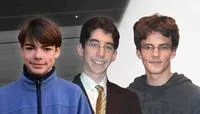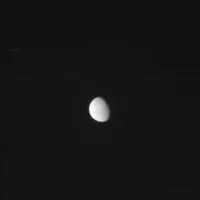Cassini Team Recruits Next Generation of Scientists
December 5, 2007
(Source: Jet Propulsion Laboratory)
 |
Cassini Team Recruits Next Generation of Scientists |
NASA's Cassini-Huygens Mission to Saturn has some young new participants. A 10th-grade student in Delaware, a high school senior in California, and an 8th-grade American student in France are the winners of this year's Cassini Scientist-for-a-Day contest. Their essays, selected from nearly 200 entries, earned them a spot in a teleconference held this week with members of the Cassini science team.
To participate, students had to select one of four images that Cassini's camera could capture on Nov. 30, 2007, and explain why they believe their chosen target would provide the best scientific results. "This is just the sort of thinking that we have to do on a mission," said JPL's Linda Spilker, Cassini deputy project scientist and one of the contest judges. "We were really impressed by the entries. The proposals were very well researched and well written. I think the future of planetary science is in good hands."
 |
Scientist for a Day - Image 1 Mimas coming out from behind Saturn |
Winners were chosen in two categories. Alexander Sharpe, who is currently living in La Bruguiere, France, captured first prize in the grade five to eight category. "The most fascinating thing about Saturn is its rings," he wrote in his essay on the importance of getting an image of Saturn's tiny moon Prometheus and the F ring.
There was a tie for first place in the grade nine to twelve category with top honors going to Joshua Leviton, a 10th grader at the Wilmington Friends School in Wilmington, Del., and 12th grader Alistair McGregor from Henry Gunn Senior High School in Palo Alto, Calif. Leviton selected Saturn's moon Tethys with its huge impact crater as his target of choice. McGregor also argued for Prometheus and the F ring, writing that "we could gain a wealth of information concerning the interactions between ring particles and larger objects in the Saturnian system."
The Cassini spacecraft entered orbit around Saturn three-and-a-half years ago and has provided a wealth of new information about the ringed planet and its many mysterious moons.
Entries in the Cassini Scientist-for-a-Day contest came from 24 states. Approximately 400 students participated in the contest either as individuals or in groups of up to four. Separate contests were also held in the United Kingdom, India and Iran. The U.S. contest winners, along with the semi-finalists joined in a teleconference with Cassini scientists on Tuesday, Dec. 4, and Wednesday, Dec. 5, where they had the opportunity to have their questions answered and contribute to this groundbreaking mission.
 |
Scientist for a Day - Image 4 Tethys and its Odysseus impact basin |
The next opportunity for students to participate in the Cassini Scientist-for-a-Day contest will be in May of 2008.
More information on the Cassini-Huygens mission can be found at: http://saturn.jpl.nasa.gov, and http://www.nasa.gov/cassini .
The Cassini-Huygens mission is a cooperative project of NASA, the European Space Agency and the Italian Space Agency. JPL, a division of the California Institute of Technology in Pasadena, manages the Cassini mission for NASA's Science Mission Directorate, Washington, D.C. The Cassini orbiter was designed, developed and assembled at JPL.
Contacts:
Carolina Martinez 818-354-9382
Jet Propulsion Laboratory, Pasadena, Calif.
carolina.martinez@jpl.nasa.gov
NEWS RELEASE: 2007-140




































